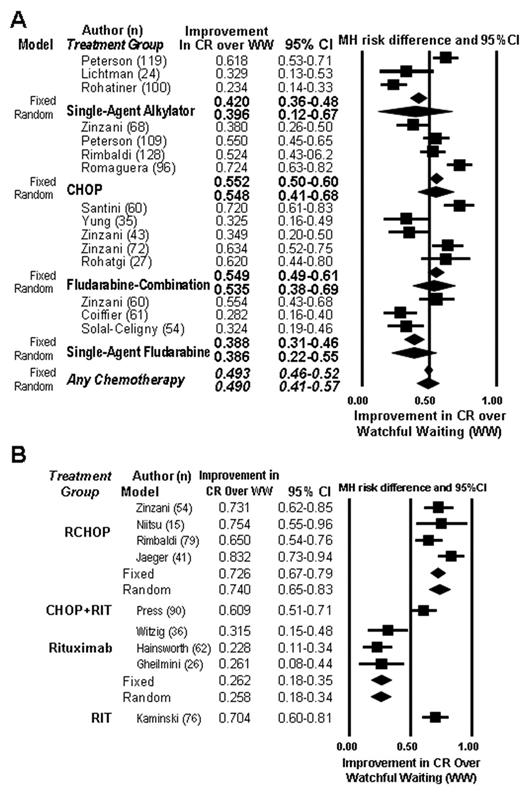Abstract
Background:Although advanced stage follicular lymphoma (FL) is considered incurable with standard therapy, and early institution of therapy has not demonstrated benefits over watchful waiting, novel strategies such as lymphoma vaccines and maintenance rituximab(R) provide opportunities for achieving prolonged disease-free intervals. Promoting the benefits of these strategies will depend upon improving the complete response rate(CR) with initial treatment. To date, the optimal first-line therapy remains undefined. To address this issue, we conducted a systematic literature review and meta-analyses comparing first-line chemotherapy regimens for FL.
Methods:We searched the Cochrane Central Register of Controlled Trials (Cochrane Library Issue 1, 2003), MEDLINE (1/1966–6/2005), EMBASE (1/1980–7/2005), American Society of Hematology Annual Meeting abstracts (2002–2004), and American Society of Clinical Oncology Annual Meeting abstracts (1995–2005). Each search used combinations of the term follicular lymphoma and terms for medications and treatment regimens. Criteria for including studies were:
Inclusion of patients with untreated stage III/IV FL;
Intervention with chemotherapy and/or immunotherapy, radioimmunotherapy, or watchful waiting;
Reporting in English of the following treatment outcome measures for patients with FL: CR/CR-unconfirmed, overall response rate (OR), and at least one form of survival data.
Extracted data included pre-treatment disease status, treatment regimen, median follow-up time, progression free survival, overall survival, CR and OR. The following treatment strategies from peer-review publications were analyzed: single-agent fludarabine(F), fludarabine-combinations(F-com), single-agent alkylators(A), alkylator-combinations (without anthracycline), and anthracycline-combinations. In meta-analyses of selected studies, we utilized the Mantel-Haenszel (fixed effects model) and DerSimonain and Laird (random effects) methods to calculate the risk difference comparing treatment regimens’ CR/CRu to the spontaneous CR in patients undergoing watchful waiting (4.6%; Ardeshna et al. Lancet, 2003).
Results:Over 1800 abstracts were reviewed yielding 37 reported treatments that met inclusion criteria and included 2709 patients. The benefits of initial chemotherapy for achieving CR are shown in Figure 1. Single-agent F and A had similar benefits, as did F-com and CHOP. Substantial heterogeneity existed among other alkylator and anthracycline combinations limiting their ability to be combined using meta-analysis. Overall, chemotherapy provided a 49% improvement in the chances of attaining CR (95% CI:41%–57%). Meta-analyses of single agent R and RCHOP showed CR of 26% (95% CI:18%–34%) and 74% (95% CI:65%–83%) respectively (Figure 1B). Insufficient numbers of studies met inclusion criteria to examine the benefits of adding R to other regimens.
Conclusions:CHOP and F-com provide the greatest likelihood of achieving CR in untreated FL. This benefit is even greater in CHOP patients who receive R. Selection of an initial regimen for patients with FL will depend on patient-specific factors and future plans for other therapies.
Author notes
Corresponding author


This feature is available to Subscribers Only
Sign In or Create an Account Close Modal